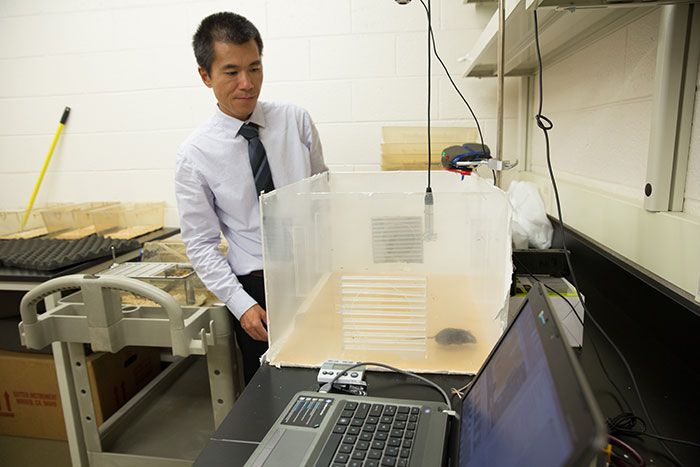By John DiConsiglio
It is the voices.
Those phantom sounds that echo menacingly through the brains of people suffering with schizophrenia. For many, it is the most terrifying aspect of their condition.
Too relentless to block or ignore, the voices often take the form of verbal tormentors who berate schizophrenia sufferers with streams of harsh insults or commands to hurt themselves. Some hear a word or phrase repeated again and again, ceaseless crystalline laughter or cacophonous screeches.
Struggling to free schizophrenia patients from the auditory anguish presents a different kind of frustration for the scientific community. To date, no one is exactly sure what happens inside their brains to explain these life-disrupting hallucinations.
“The auditory hallucinations shouldn’t be happening,” said Assistant Professor of Psychology Guangying Wu. “They simply shouldn’t be there. It’s one of the mysteries of the brain.”
Dr. Wu is trying to crack that mystery—with the help of student researchers, colleagues in other scientific disciplines and a pack of genetically engineered mice. In his lab, part of the interdisciplinary Institute for Neuroscience, Dr. Wu uses lasers and ultrasound recordings to study the tiny brains of mice for clues to schizophrenia in humans.
Dr. Wu hopes to pinpoint individual misfiring neurons within a web of billions inside the brain. Current treatments focus on the global effects of antipsychotic medications on large clusters of brain cells. But Dr. Wu thinks that by targeting single defective neurons and the network they form, his group can find insights and clues on how to comfort the world’s 55 million schizophrenia sufferers without the often debilitating side effects of current medications.
But isolating individual neurons “is like looking for a needle in a haystack,” he said. “It’s a very big haystack and a very tiny needle.”
Of Mice and MRIs
The first steps toward a possible revolution in schizophrenia science are taking place in a laboratory, where student research assistant Emily Bragg oversees a nest of 120 brown mice. A senior majoring in speech and hearing with a psychology minor, Ms. Bragg is part of Dr. Wu’s research team, which also includes a postdoctoral research scientist, a technician and a psychology graduate student.
“It’s hard to believe, but inside their brains is data that can help millions of people,” Ms. Bragg said. “It seems distant, but it’s not a stretch for me to see it.”
Dr. Wu’s research focuses on the brain’s complex system for processing auditory information. He recently received a two-year $65,000 National Alliance for Research on Schizophrenia and Depression (NARSAD) Young Investigator Grant from the Brain and Behavior Research Foundation to study communication in mice for answers to schizophrenia’s symptoms.
Scientists such as Dr. Wu have theorized that the auditory hallucinations experienced by 70 percent of people with schizophrenia—and 15 percent of those with mood disorders like depression—are caused by enhanced brain activity. They believe schizophrenia over-stimulates brain cells, either in the prefrontal area, which controls our reasoning, or in the cortex, our auditory region.
“For healthy people, these areas are well-controlled. They are not generating excessive spikings of neurons because the excitation and inhibition is balanced in these regions,” Dr. Wu explained. “But for people with disorders, those neurons spontaneously generate too much activity, even when there is no actual sound to stimulate them. There’s nothing there—no sound. But the neurons are discharged accidentally anyway.”
Those conclusions remain only theories for now because there is no good technique for directly testing the human brain. The most up-to-date imaging method is the functional MRI. But that instrument lacks the precision and resolution to identify individual neurons and observe how they interact with networks of brain cells. “The functional MRI captures hundreds of thousands of neurons at the same time,” Dr. Wu said.
His goal is to capture the activity of a single neuron.
That’s why he turned to mice. Their brains are small but, like humans, they contain distinct visual, auditory and olfactory fields. Dr. Wu works with transgenic mice, rodents that have been engineered to carry a gene that increases their likelihood of developing schizophrenia. Their altered brains emit fluorescent light waves that Dr. Wu’s team captures with a device called a two-photon laser-scanning microscope. His team triggers the mice neuron with sounds by either piping tones into their glass cases or even placing tiny headphones over the animals’ ears. The laser maps the fluorescent neuron readings with and without the sound stimulus.
If the neurons fire too much when no sound is present, the mice brains show likely schizophrenic conditions.
A Collaborative Effort
But how does one determine which mice have schizophrenia?
“It’s not like humans,” Dr. Wu said. “We can’t interview them.” Instead, Dr. Wu’s team monitors the rodents’ speech patterns.
Ms. Bragg said that humans with schizophrenia can have disjointed, nonsensical speech. “We look for roughly the same thing with mice,” she said.
All of Dr. Wu’s transgenic mice are male. Unlike female mice that communicate through squeaks, males vocalize at a range that can’t be heard by human ears. Using ultrasound technology, Dr. Wu’s team records and compares the male mice “songs” to determine which have schizophrenic symptoms.
He theorizes his research will reveal that the enhanced brain activity is the result of an imbalance in chemicals. Perhaps dopamine, the neurotransmitter that excites the brain, is elevated. Or maybe there are reduced levels of glutamate, the chemical that activates inhibitor neurons to “silence the brain,” Dr. Wu said. Or both scenarios may be present.
Most antipsychotic drugs regulate dopamine and glutamate levels. But they have shown only varying success and often cause a profusion of side effects like involuntary movements and abnormal behavior. “From a pharmacology point of view, if we know exactly which neurons to pinpoint, we can design more efficient and safer drugs,” Dr. Wu said.


